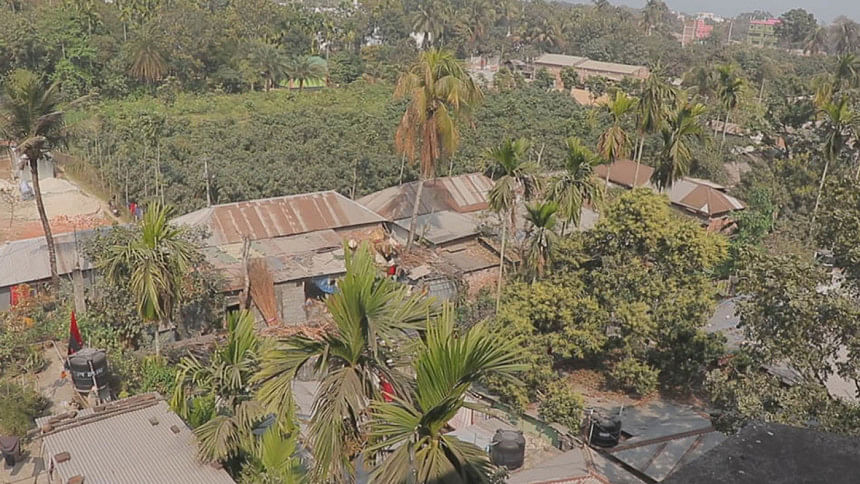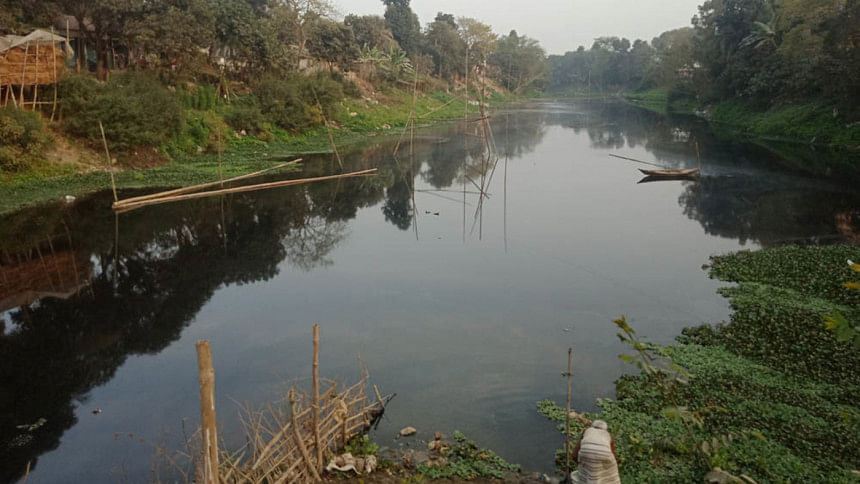Death of Boral, destruction of Chalan Beel

A long line of buildings are marked with a red cross at Bonorupa housing society in Bonpara municipality area in Natore's Boraigram upazila.
The ominous red cross signifies the structures are illegal and marked for eviction.

The housing society is one example of how influential grabbers have occupied a large portion of the Boral river, a major river in the Chalan Beel region, over the years, while the local administration stood by.
It is not just private individuals who grabbed and occupied river land, several government projects and offices have set up buildings on it too.
Ironically, these include the Bonpara Land Office and an Ashrayan project, which builds housing for the ultra-poor, also on occupied river land.
In this way, several thousand structures have been constructed in the Bonpara area illegally on river land over the years. Due to the rampant encroachment, there is now no sign of the Boral river's previous existence in the area.
The disappearance of 18 kilometres of the Boral river from Atghori to Bonpara due to encroachment is detailed in the 2018 annual report of the National River Conservation Commission (NRCC), Bangladesh.
The Daily Star spoke to several of the residents of the housing society who, however, claimed they have legal documents of the land and are not illegal occupiers.
Nur Md Al Mamun, a Bonorupa resident, said that while the river was a single plot in the CS [Cadastral Survey] record of 1922, in a following survey -- called the petty settlement in 1934 -- conducted in the Bonpara area, the land went to the public.
After that, the plots are named after locals in the three records published, he said.
"This is not our inherited property. We bought the land after seeing proper land documents and invested in this property to construct the Bonorupa residential area here over the last three decades.
"We are not illegal occupiers. We have bought the land, paid revenues to the government, taken plans from the government offices, taken bank loans showing legal documents, then invested here," he added.
Md Jahangir Alom, Boraigram upazila nirbahi officer, however told The Daily Star, the grabbers did not occupy such a large amount of river land overnight. This is why even government offices and housing projects have been built on it since.
A massive eviction drive is needed to free the river which needs significant logistical support, he added.
"When we will get sufficient logistical support and all the relevant authorities work together, then only eviction can be started," the UNO said.
"The river is a living entity, so nothing should be built occupying river land. And according to the CS survey, this is identified as river land," the UNO added.
According to the 2018 NRCC report, the Boral river has been massively occupied in Natore, Rajshahi, Pabna, and Sirajganj districts.
The names of 1,044 illegal occupiers in Natore district were published in 2018 but the names of illegal occupiers in the other districts are not yet known.
Not just construction, river land has also been occupied for cultivation. On visiting the Zonail area of Natore, this correspondent found the farmers of the village occupying the entire river bed for cultivating crops.
The Boral river has also been polluted due to unplanned development and dumping of household and industrial waste.
At Chatmohar Natun Bazar Kheyaghat area in Pabna's Chatmohar upazila last month, this correspondent found toxic water stagnant at a key point of the Boral river.
Household sewerage lines are directly linked to the river while markets, shops and poultry farms in the area also dump their industrial garbage here turning the river water toxic, especially for fish.
"The garbage of eight municipalities in four districts beside the Boral river are dumping waste here in the river. Besides this, industries dump their toxic waste in the river," said Mizanur Rahman, secretary of Boral Rokhha Andolon.
The 220km long Boral river, which forms a link between the Padma and Jamuna rivers through four districts and flows into Chalan Beel, has already filled up in many areas and lost its regular flow of water in the vast water body.
Issuing from the Padma, it starts at Charghat upazila of Rajshahi and flows for 46km till Atghori point at the border area of Boraigram and Bagatipara upazilas.
After that, a section of the river -- named Nondokuja -- flows to Chanchkore point of Gurudaspur upazila while the main Boral once flowed from Atghori to Bonpara through Walia, Bhabanipur, and Rahimer Bottola areas. This stretch no longer exists due to rampant encroachment.
The Daily Star, on visiting most of these areas mentioned, found structures everywhere on the occupied river land.
The damage to Boral, one of the leading rivers in the Chalan Beel region, over the past three to four decades due to reckless encroachment and pollution, has also brought about the massive destruction of Chalan Beel, according to river experts.
"The Boral river lost its original course due to natural whimsicality as well as immature development projects in the river over the years," Md Sajidur Rahman, water consultant of NRCC, told the Daily Star.
After the construction of sluice gates at the Atghori point of the river in the '80s and a few other water regulators, the Boral river started seeing drastically reduced flow. The river has now dried up in many areas, said Sajidur, also the former divisional chief engineer of the Water Development Board.
In the early '80s, the water resources ministry had constructed three sluice gates/three plus 2 downstream -- one in off take of the river in Charghat of Rajshahi, middle segment of the river in Atghori in Natore, and lower segment of the river at Nurnagar in Pabna.
The Boral is crucial for the flow of water in Chalan Beel as all of the rivers, canals and waterbodies in it are linked to it, said Mizanur.
"The sluice gates were constructed 30-feet-wide and eight-feet-long, although the river was over 500 feet wide at the time.
A minimum of 21,000 cusecs of water is released from the Padma in the dry season; after setting up of the sluice gates, the flow of water came down to 5,000 cusecs since 1985," Mizan said.
At the same time, the LGRD and Roads and Highways Division made four cross dams, dividing the river into several parts and also constructed concrete roads at the heart of the Boral river in Chatmohar upazila of Pabna.
In this way, the once fluid Chalan Beel -- as suggested by its name -- also lost its flow of water year-round. Now, most parts of the beel remain stagnant or dry, with water only flowing during the monsoon, he said.
Due to the rampant grabbing and pollution of Boral river, the vast Chalan Beel has also been destroyed, said Mizanur.
Following local movements against the rampant encroachment and pollution of the river over the years, the water resources ministry conducted a detailed feasibility study with an Environmental and Social Impact Assessment for restoration of water resources of the Boral river in 2018.
Published in 2019, the report's key recommendations included removing illegal structures for freeing river, to increase flow of water through reconstructing sluice gates, dredging the river as a necessity, that no untreated sewage be discharged in the river, in order to bring about navigability in the Boral river and for saving Chalan Beel.

 For all latest news, follow The Daily Star's Google News channel.
For all latest news, follow The Daily Star's Google News channel. 



Comments